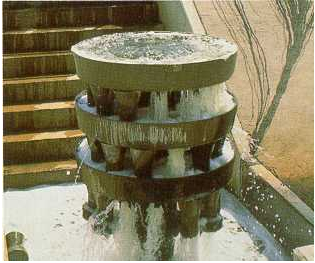Aeration
Aeration is a unit process in which air and water are brought into intimate contact. Turbulence increases the aeration of flowing streams. In industrial processes, water flow is usually directed countercurrent to atmospheric or forced-draft air flow. The contact time and the ratio of air to water must be sufficient for effective removal of the unwanted gas.
Aeration as a water treatment practice is used for the following operations:
* carbon dioxide reduction (decarbonation) * oxidation of iron and manganese found in many well waters (oxidation tower) * ammonia and hydrogen sulfide reduction (stripping)
Aeration is also an effective method of bacteria control.
Contents
Suitable conditions
Temperature significantly affects the efficiency of air stripping processes. Therefore, these processes may not be suitable for use in colder climates. Theoretically, at 68°F the carbon dioxide content of the water can be reduced to 0.5 ppm by aeration to equilibrium conditions. This is not always practical from an economic standpoint, and reduction of carbon dioxide to 10 ppm is normally considered satisfactory.
Construction, operations and maintenance
Two general methods may be used for the aeration of water. The most common in industrial use is the water-fall aerator. Through the use of spray nozzles, the water is broken up into small droplets or a thin film to enhance countercurrent air contact.
In the air diffusion method of aeration, air is diffused into a receiving vessel containing counter-current flowing water, creating very small air bubbles. This ensures good air-water contact for "scrubbing" of undesirable gases from the water.
Reference manuals, videos, and links
Acknowledgements
- Chapter four: Aeration. GE Power and Water.
